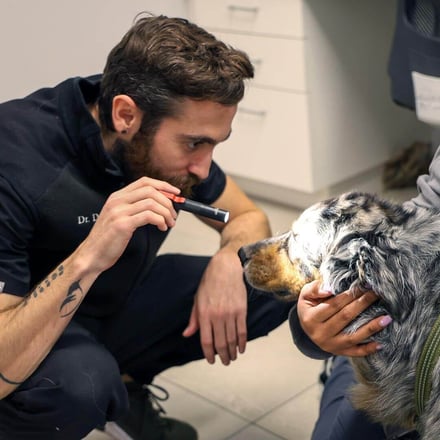Neurological Disordersin Dogs & Cats
Home » Conditions We Treat

Understanding Your Pet's SymptomsWhere does the problem lie?

Like people, dogs and cats have a nervous system consisting of a brain, spinal cord, nerves, and muscles. The nervous system helps the body interact with its surroundings through vision, touch, smell, hearing, and balance. It also tells the rest of the body what to do by initiating and controlling movements.
When the nervous system is unhealthy, the symptoms can be dramatic. While neurological symptoms alone can’t tell us exactly what the problem is, they can tell us where the problem is.
- Seizures
- Tremors
- Head tilt
- Head pressing
- Bumping into walls
- Leaning or rolling to one side
- Walking in circles
- Incoordination
- Balance issues
- Confusion
- Behavior changes
- Blindness
- Head held low
- Muscle spasms in the neck region
- Yelping in pain
- Weak or wobbly gait in all four limbs
- Paw knuckling, scuffing, or dragging in all four limbs
- Inability to walk in all four limbs
- Back arched
- Muscle spasms in the back
- Yelping in pain
- Limp tail
- Weak or wobbly gait in the rear limbs
- Paw knuckling, scuffing, or dragging in the rear limbs
- Inability to walk in the rear limbs
- Paralysis of the rear limbs
- Urinary or fecal incontinence
- Weakness in all four limbs
- Difficulty walking more than a few steps
- Inability to walk in all four limbs
- Shaking of the limbs
- Weak bark
Common Conditions We Treat
at Southeast Veterinary Neurology
Helping people understand their pets’ conditions and offering them answers—and hope—is what we love most about what we do. Neurological cases can be complex, confusing, and intimidating to pet parents, but a pet neurologist can clarify these issues and lay out a plan to help you resolve them. Since we focus exclusively on conditions of the brain, spinal cord, nerves, and muscles, your pet will receive expert care from every member of our team.
At Southeast Veterinary Neurology (SEVN), our specialists are able to diagnose and treat a wide variety of neurological disorders in dogs and cats. Here are some of the conditions we commonly treat.
AA luxation is a spinal disorder in which there is excessive movement between the first two bones in the neck. This condition is most common in small breed dogs, often due to hereditary factors where the AA joint forms incorrectly.
It is not uncommon for older dogs and cats to develop brain tumors, which can be categorized as either primary (forming from the cells and lining of the brain) or secondary (originating elsewhere in the body and spreading to the brain).
Cervical disc disease is when one or more discs (the cushions between the vertebrae) in the neck wear down and rupture, causing compression of the spinal cord and various symptoms including weakness, wobbliness, neck muscle spasms, and buckling of the front legs.
Chiari-like malformation (CM) is an abnormal bone growth inside the back of the skull. This puts pressure on the brain and disrupts the flow of cerebrospinal fluid, which can result in syringomyelia (SM), a fluid-filled cyst formation within the spinal cord.
Discospondylitis is a condition in which an intervertebral disc and its adjacent vertebrae become inflamed due to a bacterial or (less likely) fungal infection. Dogs with discospondylitis may act painful and have difficulty walking. Large-breed male dogs are most commonly affected.
Encephalitis is swelling of the brain that may have infectious or noninfectious causes. Clinical signs may include seizures, lack of balance, walking in circles, behavior changes, and blindness. Inflammatory disease can also occur in the coverings of the brain and spinal cord called the meninges (meningitis) and in the spinal cord (myelitis).
FCE occurs when a piece of fibrous cartilage blocks blood flow to a section of the spinal cord. Without a blood supply, this section goes without essential oxygen and nutrients, which can lead to spinal cord dysfunction.
IVDD can be described as a slipped disc, ruptured disc, herniated disc, or bulging disc, depending on the type of damage that occurs. If a disc swells or ruptures, it may strike or compress the spinal cord, affecting an animal’s ability to walk.
Seizures occur due to an abnormal burst of electrical activity in the brain. What causes seizures can be separated into 3 categories: problems that happen outside of the brain, but have a secondary effect on the brain; structural problems inside the brain; and idiopathic epilepsy, which is the most common cause of seizures in dogs.
Strokes may be caused by bleeding in the brain due to high blood pressure, clotting or platelet disorders, or metastatic cancer. Other causes include closing or blockage of a blood vessel due to hypothyroidism, kidney disease, cardiac disease, or Cushing’s disease.
Vestibular disease is when a pet has balance problems, which are characterized by a head tilt, poor coordination, and unusual eye movements. From your perspective, it may seem as if your pet has vertigo.